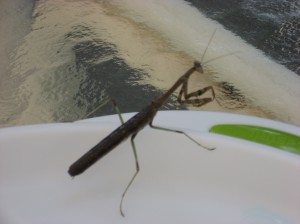My all-new middle grade was recently the focus of a successful Kickstarter campaign. (Whoo Hoo!) . . . Which means that now I am busy getting it out to all the wonderful people who contributed to the project.
Here’s a little teaser on the whole mantid/mantis debate.
Mantid or Mantis? In Double Z: Day of the Mantid, Zach Zinsky is a big fan of fun and funny practical jokes. So, one day he hides a number of praying mantid egg sacks in his classroom, hoping for a break from the torturous perfection of his teacher, Ms. Paradise. So what about these bugs, anyway? I did a little research to find out more about these incredible insects. [Include pictures] Did you know: • First off, let’s clear up the issue of spelling. There are around 2,000 species of this insect. The whole shebang is referred to as mantids. The word ‘mantis’ focuses on a small subgroup of these amazing insects. And praying? Well, check out the position of the mantid’s front legs. Kind of looks like it’s in a prayer stance, right? • Don’t try to sneak up on a mantid. These creatures are the only insects able to rotate their heads a full 180 degrees. Imagine if a teacher had that same ability? Kind of gives a new meaning to ‘eyes in the back of her head’, doesn’t it? • Ootheca who? In the fall, female praying mantids deposit their eggs on a branch and then wrap these in a protective cocoon that will last all winter. As the weather gets warmer, 100 to 200 small, praying mantid nymphs will hatch from a single egg sack. That’s a lotta little ones! • Yum yum—now I’m going to eat you! If praying mantids could talk, they might say something like this. In fact, it’s true that sometimes female praying mantids eat their mates. Also, if there’s nothing else to eat, the newly hatched nymphs will also munch on their brothers and sisters.

